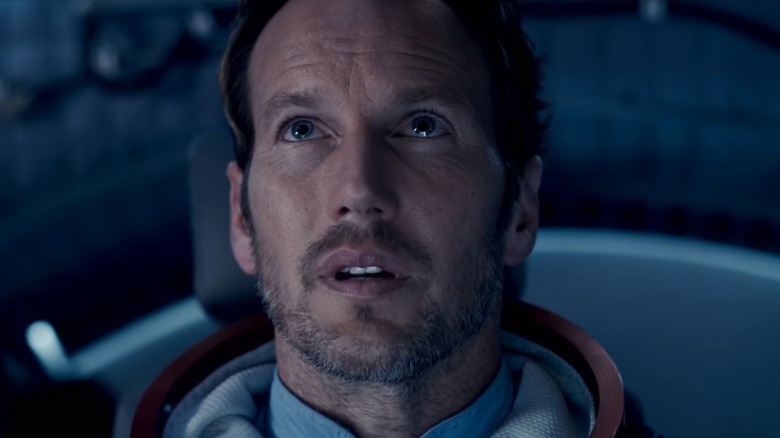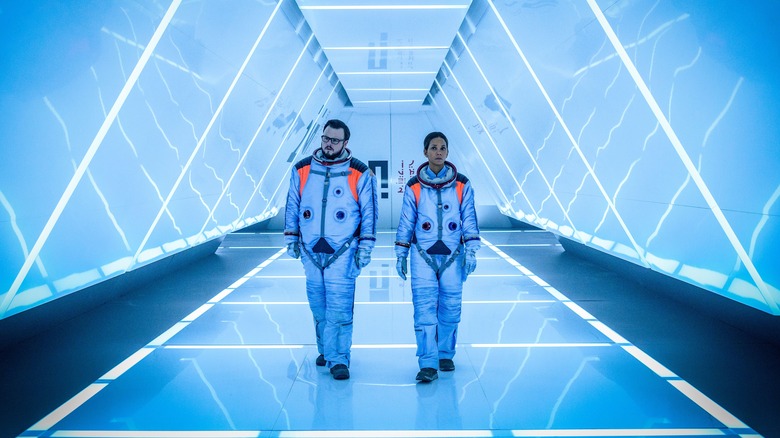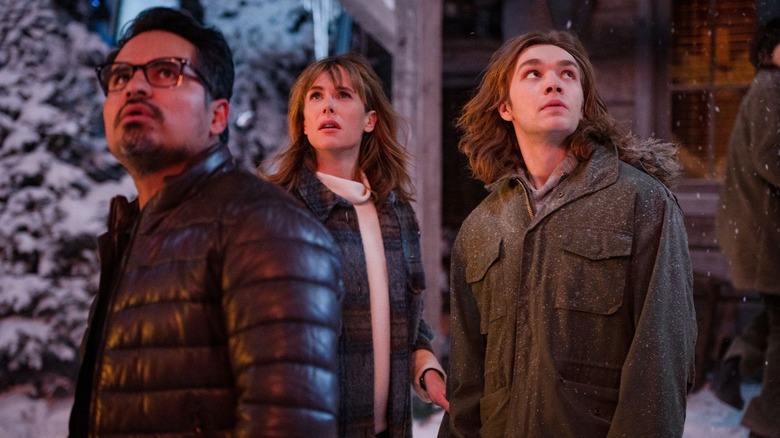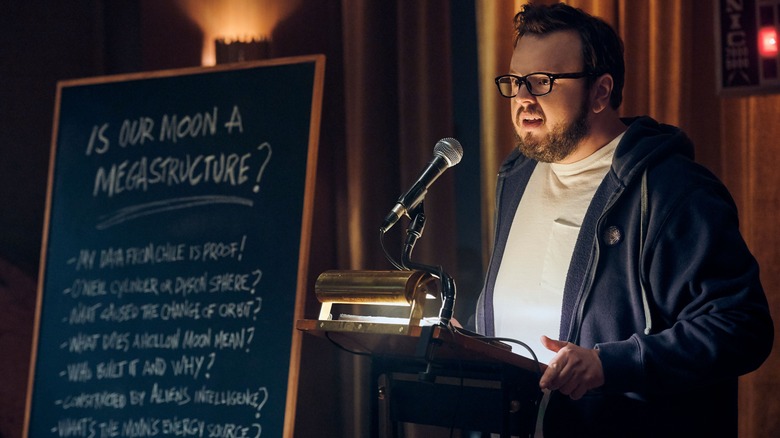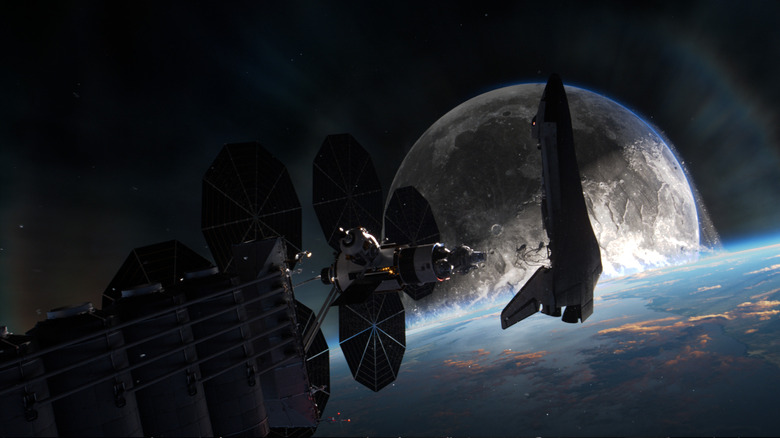Biggest Unanswered Questions In Moonfall
For a movie ostensibly about the moon hurtling towards Earth and the insane secrets behind that same moon's true nature, "Moonfall" doesn't always stick the landing in the adequate explanations department. It's a blast at times, sure, and it's not like anyone is going in expecting the heights of dramaturgy from Roland Emmerich, the man who gave us "The Day After Tomorrow" and whatever "Anonymous" was. That said, for every Earth-shattering revelation in the film's overachieving final act, there's an equal and opposite question left unanswered for gobsmacked moviegoers to contend with all on their own.
Luckily, we're here in an attempt to parse through the ones most likely to be lingering in your mind while you sit through the credits, wondering if there's going to be an extra scene at the end (there isn't).
But we're here just the same. Some of these may be bargain bin plot holes, while others are legitimate mysteries, but a stone unturned is a stone unturned. Let's turn some stones!
Spoilers to follow!
How did K.C.'s leak gain such fast traction?
At the beginning of "Moonfall," K.C. (John Bradley) discovers that the moon has fallen out of its orbital path and is on a collision course with Earth. He makes multiple hilarious attempts to get through to NASA at various channels, to no avail. By the time he meets Brian Harper (Patrick Wilson) in the flesh and gets laughed out of the building, literally, he seems ready to give up on his quest to show the world the truth about the moon. But a fateful visit with his mother gives him the requisite courage to make his voice heard, by hook or by crook.
He leaks his findings through the press and becomes the anonymous source cited in every media briefing about the moon that sets the film's plot in motion. This allows the public panic to put enough pressure on the world's governments to address the problem at hand. But how did his concerns become accepted so fast?
It's firmly established that K.C. and his conspiracy theorist status are treated with the polar opposite of credulity. We also know from the scenes set within NASA analyzing the data about orbital trajectory that his findings aren't even easy to unpack, even for literal rocket scientists. How did he get his message out in a way that went viral and gained traction? What did he do differently than every other one of his peers who were labeled as crackpots unworthy of even a second passing thought?
By all accounts, he should have ended up on the cover of the National Enquirer, if not a below-the-fold blind item easily ignored in the checkout lane of a grocery store. Very strange!
Just how much did NASA really know about the moon?
In the middle of the film, it's revealed that NASA has known that the moon is not what it seems for sixty years, as told to Jo (Halle Berry) by mysterious spook Holdenfield (Donald Sutherland). It's clear from his tone and how brief his expository introduction is that NASA couldn't have known the full depth of the moon's origins. Yes, NASA knew "something" was wrong up there. They knew the moon was hollow. They knew there was a terrifying wraith made up of little nanobots. But were they aware of how it was really built by the original human race that proliferated throughout all of space before being wiped out by those same evil nanobots?
The only thing to suggest someone involved with the cover-up project may have known more than they were letting on is the fact that they developed the film's major MacGuffin, the EMP device. That device was constructed to be used against the black swarm, which implies they at least knew it was a malevolent force they would need to contend with at some point, budget cuts be damned.
But then again, given how quick the military was to settle on "nuke the moon" as a solution, maybe making a basic weapon was just the best idea they had at the time.
Why did Tom settle on Colorado as a hideout?
When the stuff starts to really hit the fan as the moon grows closer and closer to Earth's orbit, Tom (Michael Peña), Brian's ex's new husband, insists on taking their new blended family to his winter resort spot in Colorado. Now, there is a doomsday bunker a couple of hours from where Tom chooses to post up, but he doesn't know that. Why does he think they're going to be safer in the mountains?
Now, one of the initial side effects of the moon getting nearer to Earth is the absurd impact it has on our oceans and the tides, so coastal communities are hit first and hard by flooding out of nowhere. But in true Roland Emmerich fashion, the devastation caused by this unlikely global event is so widespread and varied that there is literally nowhere on Earth that is truly safe other than a state-sanctioned doomsday bunker.
Given how catastrophic things get for Tom, Sonny (Charlie Plummer), and the rest of the gang in the mountains, between armed robbers, meteorites, and gravitational tomfoolery, perhaps they could have saved some time and energy just seeking more local high ground.
Are all moons megastructures?
K.C. introduces himself as a "megastructurist," a conspiracy theorist who believes that the moon, and really all moons, aren't the naturally occurring phenomenon we've all been led to believe by accepted scientific fact. Instead, they are hollow supermachines designed by advanced alien life forms. The film's climax proves that K.C. was at least half right. The moon is a megastructure with a hollow core and super sophisticated machinery powering it from the inside. But it wasn't aliens that created it, but rather the original humans who created moons to act as arks aimed at preserving the human race after a war with the artificial intelligence their society had created.
We're shown glimpses of this war and the destruction it caused when the moon's operating system teaches Brian the secret history of humanity. We see that many moons were created with the explicit purpose of seeking out hospitable pockets of space from which new planets can be formed and seeded with human life. This grandiose infodump implies that Earth's moon is the only successful ark, having birthed Earth and given humanity a fighting chance at a future after a war they seemingly lost with the machines.
But from Earth, we can observe other moons. The film doesn't have room to tackle whether or not all moons are megastructures designed by humans or if some of them are naturally occurring celestial bodies. Maybe some or all of them are megastructures, but they weren't made by humans, and humans aren't the only sentient life in the universe capable of creating such colossal inventions.
Because the mythology of the moon isn't fully introduced until so late in the game, and it's explained so quickly to get back to the action, there's a lot we still don't know. Which begs the question...
Are we going to get a Moonfall 2?
"Moonfall" may be distributed by Lionsgate, but it's one of the more expensive independent productions in recent memory, getting its $140 million-plus budget from a variety of lone gunmen financiers. But in today's pop cultural climate, every new piece of media has the potential for sequelization. Whether or not "Moonfall" makes a sufficient return at the theatrical marketplace this weekend and the ensuing weekends of its release remains to be seen. Still, there's plenty left on the table here to explore for a follow-up feature or spin-off streaming series.
Brian has now returned to Earth with new knowledge about humanity's secret history. What can he do with that knowledge to move our species onto the right course of replicating the original humans' advances socially and technologically? Can he do so in a way that doesn't beget more evil artificial intelligence or a resurgence of the machine war?
Are there any humans left out there that have survived the black swarm onslaught, even in some tiny pocket in some galaxy far, far away?
But more importantly, in the film's closing moments, when K.C., having sacrificed himself to save Earth, has his consciousness scanned into the moon's operating system, he's told they have work to do. With no post-credits scene to tease what that work might be, perhaps a sequel is necessary to explore where Earth and the whole of humanity go into this new future.
All that, of course, depends on whether or not ticket sales translate to mass public interest in answers to these questions or if Roland Emmerich will skip along to the next over-the-top disaster movie. Maybe something under the ocean, or about evil plants? The sky is the limit. For now, though, fingers are crossed for more moon shenanigans.
